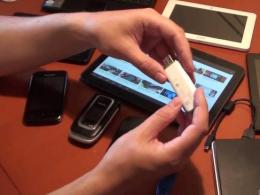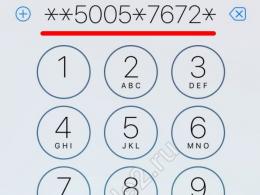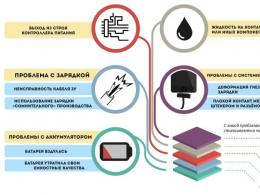Windows Update errors. Solving Windows Update errors Failed to install definition updates
On the this moment There are three different issues Windows 10 users face when installing updates. Firstly, this is an error downloading the update or freezing the download process. Secondly, these are problems during the installation of the update, and finally, the system crashes with a BSOD after a reboot. Below are a few possible solutions for troubleshooting.
Fixing Windows 10 update download issue
The update is not downloading
If the cumulative update does not download, try the following steps:
Disable your antivirus and VPN/Proxy client before updating.
Wait for the update to install, sometimes this process may take a long time depending on the speed of your internet connection.
Note. To quickly find out the version number and Windows builds 10, enter in search string winver , press Enter and you will see a dialog box with information about the current OS version.
If the update fails, you can use the built-in Troubleshoot tool in Windows 10 to fix the problem.
Press combination Windows keys+ i to open a window Parameters. Go to menu Update & Security > Troubleshooting. Then in the section select the option Centre windows updates and click the "Run the troubleshooter" button.

If the cumulative update hangs while downloading or installation fails, then something has gone wrong with the update files. After clearing the folder containing the update files, Windows Update will try to download the update components again. IN Windows Explorer go to the following location:
C:\Windows\SoftwareDistribution\Download

Delete all files/folders, but don't delete the Download folder itself. Select all files and folders using CTRL + A and press the Delete key to delete. Restart your computer and run the update procedure again.
If the cumulative update hangs while downloading, try the following solution:

- Enter Services
- Scroll to service Delivery Optimization.
- Click right click click on the service and select "Properties".
- Change the "Startup Type" to "Manual".
- Restart your computer.
- If Windows 10 update still freezes, change the startup type to "Automatic (Delayed Start)".
Stop the Windows Update service
If stopping the Delivery Optimization service does not solve the problem, try stopping the service Windows Update. If the Windows 10 update is stuck at the “Initializing...,” try the following solution:

- Click on the "Start" menu icon.
- Enter Services and launch the classic application of the same name.
- Scroll to service Windows Update.
- Right-click on the service and select Stop.
- Restart your computer.
- Check for new updates.
- The update should proceed normally.
Windows Update Reset Script

Completely reset the Windows Update client settings. It has been tested on Windows 7, 8, 8.1 and Windows 10. The script will set up services and registry keys related to Windows Update, restoring the default settings. It will also clean up files related to Windows Update.
Fixing Windows 10 update installation issue
In some cases, you may encounter a problem installing an update. If the installation of the update is stuck at some stage, then try the next solution.
If your computer freezes at the stage, then follow the instructions below.

- While holding the power button, turn off the machine.
- Turn on your computer and boot into safe mode.

- Sign in account(if necessary).
- Before continuing, make sure that all virus scanners disabled.
- From the start menu, type Recovery and select the appropriate desktop app.
- Click .

- Select an earlier restore point, and then click Next.
- Follow the instructions to start System Restore.
- Wait while your computer completes the system restore process.
- Regardless of whether the restore succeeds or fails, you are likely to get rid of the “Preparing for Windows setup. Don't turn off your computer."
- Sign in to your account if required.
- Disable virus scanners before continuing.
- Start the Windows update process.
- The update should now install without problems.
Some users may encounter a stop error causing the display blue screen death (BSOD) during system reboot.

If you're experiencing a BSOD crash while updating Windows 10, check out the article:
If the BSOD problem persists, then follow the steps to uninstall and reinstall the potentially problematic update on your device. Alternatively, you can prevent Windows from installing the problematic update:
Other Windows 10 update issues
After installing Windows 10 updates, you may encounter some issues such as internet connection errors.
To fix these issues, you need to run the following commands from a command prompt (cmd.exe). In the search box on the taskbar, type Command line, press and hold (or right-click) "Command Prompt" and select "Run as administrator". After opening the command prompt, enter the following commands one by one:
netsh winsock reset catalog netsh int ipv4 reset reset.log
If you are still experiencing the "No Internet Connection" issue, please update your computer's IP address. To do this, open command line(Windows + R , type cmd.exe and press Enter) and enter the following command:
ipconfig /renew
Disable Windows 10 update and drivers
Pause update


Users Pro versions or Enterprise can also use the editor group policy to prevent installation of drivers for specific devices:
DISM Commands to Check Windows 10 Issues
You can use the official DISM commands to restore a Windows image to fix any problem with your updates. Before you start, it is recommended to make a full system backup or create a system restore point in case something goes wrong.

Using the CheckHealth option in DISM
The command in DISM allows you to detect potential corruption. This command is only used to find corruption, but does not perform troubleshooting operations.
- Type in start menu search Command line, right-click on the link that appears and select "Run as administrator" because DISM requires device administrator rights to run.

Using the ScanHealth option in DISM
The command in DISM allows you to scan the Windows image for any corruption. Unlike /CheckHealth, /ScanHealth can take up to 10 minutes.
To start it given command do the following steps:
- Type in start menu search Command line
- At the Command Prompt, type the following command and press Enter:

Using the RestoreHealth option in DISM
The command in DISM allows you to automatically carry out the procedure for repairing damaged Windows images. Unlike /ScanHealth, the /RestoreHealth check can take up to 10 minutes.
Follow these steps to run this command:
- Type in start menu search Command line, right-click on the link that appears and select "Run as administrator".
- At the Command Prompt, type the following command and press Enter:

Note: while running /RestoreHealth or /ScanHealth, you may notice the procedure hanging between 20% or 40% - this is completely normal behavior.
As you know, starting with Windows XP, Microsoft has been constantly releasing so-called system updates and service packs. However, it is worth noting that in Windows 7, for some reason, the update error is much more common than in other operating systems. What to do with it, we will now figure it out.

Why does Windows 7 need an update?
If earlier system updates were mostly about security, recently (in particular for Windows 7) they even affect some of the main device drivers, as well as specialized platforms. Microsoft type.NET Framework, which are required for some programs and applications to work.

As for the problems, these are mainly the errors of Windows Update 7 and the file itself, which is responsible for starting the process of searching for and installing updates to the system. Now we will dwell on the causes of errors and solutions to some of the most common problems in a little more detail.
Error installing Windows 7 updates: causes
If we talk about the reasons, they, unfortunately, can be quite a lot. First of all, this should include a disabled automatic update, damage to the update file under the influence of viruses and malicious codes, mutual conflicts between the firewall, antivirus and update service, incorrect completion of the update process, etc.
Although Windows 7 can present with different manifestations of the update error, for each situation, you can find the most appropriate effective solution to the problem.
Automatic update check
Let's start with the simplest situation. It may very well be that the automatic search and installation of updates is simply disabled. To check these settings, you must use the "Update Center", where the update method line must contain either the automatic start option or the search option followed by an installation suggestion.

Note that even if such parameters are applied, the system immediately starts scanning for official updates on the Web, or rather, on the official website of the Microsoft Update Center, since the system initially refers to it.
Manual update
If in Windows 7 the update error remains after turning on automatic mode, you can use manual search.

If everything goes smoothly here and the system prompts you to install the updates found, you just need to click the appropriate button. If after that the problem is not eliminated, more effective measures will have to be taken.
First of all, you need to check the system disk (on which, in fact, Windows 7 is installed) for errors. To do this, it is better to use the command line, and not the disk properties called through the "Explorer". For example, in the "Run" menu, you can write the command chkdisk c: \ f, which allows you not only to check, but also automatically correct system errors.
If the error repeats over and over again, the reason for its appearance may be that the file itself, which is responsible for starting the update process, is damaged. In this case, you need to perform a deep scan with any anti-virus software, but it is better to use utilities that have the general name Rescue Disc, which are launched even before the system starts from optical media.
Firewall and antivirus issues
An equally common situation, when in Windows 7 an update error appears even after all of the above actions, there is a process conflict hidden from the user's eyes with regular antivirus or firewall.
It is clear, after all, that the update program refers to a reliable source (in this case, directly to Microsoft resources), so before starting the update process, they can be disabled for a while, but only on condition that the preliminary check showed the absence of viruses and threats.
Error after Windows 7 update
Now directly about the most common mistakes, apart from what was described above. Windows 7 update error codes are enough big base data, consider the three most frequently manifested.

Error 643 is related to the inability to update the Microsoft .NET Framework. Other components of the system can be updated, but it is her update that causes the error. It should simply be removed from the system and reinstalled, after downloading the latest version from the official Microsoft website. By the way, with regard to uninstallation, it is better not to use the standard tools from the Programs and Features menu. In this case, advanced uninstallers come in handy, removing absolutely all residual files and system registry key entries from the system.
One of the most powerful programs iObit Uninstaller is a utility of this type, which has a special Forced Uninstall mode.

No less common is the error with the code 800b0100. In this situation, the most acceptable solution would be to use automatic problem fixers such as Fix It or system update readiness tool. In most cases, they are able to fix problems automatically, even without user intervention.

But the biggest headache for many users is the error code 0xc0000005. It appears after installing updates to the system. Usually, given type The error is caused by updates in the form of packages KB2859537 and KB2872339. Removing them also allows you to get rid of annoying errors.
The easiest way is to type in the command line wusa.exe /uninstall /kb:2859537 or the same, but only for the KB2872339 package (of course, you must be logged in as an administrator). If this does not help, you will have to use the update log, in which all packages should be sorted by date. Most likely some latest update and causes crashes. Now you need to remove the packages one by one, each time restarting the computer until the error disappears (you can use the same command line). When the problem is fixed, you can manually install the updates again, but exclude the problematic packages from the list.
This article covers several ways you can fix Windows Update errors.
Sometimes, when installing Windows updates, various problems and errors can occur. The most common errors that the user encounters are too long to scan or download updates, as well as an error downloading or installing an update.
CONTENT:1
How to Fix Windows Update Errors Using the Troubleshooter
If you have problems installing updates, use the Windows Update troubleshooter built into your operating system.
Run the troubleshooter by opening:
Windows Settings ➯ Update & Security ➯ Troubleshoot
On the right side of the window, in the section Run and troubleshoot select Windows Update and press the button Run the troubleshooter

This will launch the troubleshooting tool.

When the scan is completed, some of the problems may be fixed automatically. For other problems, you can choose Apply fix or Skip fix for other troubleshooting or exit the wizard.

At the end of the utility, information about detected and fixed problems, as well as problems that could not be fixed in automatic mode, will appear. Click the Close button and restart your computer. After the reboot, try installing the updates again on Windows Update.

If the built-in troubleshooter failed to fix Windows Update errors, use the following method.
How to Fix Windows Update Errors by Restarting Services
If the update takes too long to download (hangs), then you should try stopping and starting (restarting) the services associated with Windows Update.
Stopping services:

How to Fix Windows Update Errors by Clearing the Update Cache
The operating system saves update files to the "SoftwareDistribution" folder in the Windows system directory
To clear the update cache, run the following commands as an administrator and sequentially:
attrib -r -s -h /s /d "%SYSTEMROOT%\SoftwareDistribution"
del "%SYSTEMROOT%\SoftwareDistribution" /q /s

How to Fix Windows Update Errors Using "Reset Windows Update Agent"
"Reset Windows Update Agent" is a tool that will help you fix errors and problems when updating Windows. This script will be useful when system updates are not detected, downloaded or installed.
"Reset Windows Update Agent" allows you to fix errors in related components, instead of using more drastic measures, such as before
Run the script as an administrator, after that the tool will offer the following options to fix problems and update errors operating system Windows:1. Open the "System Protection" settings.
2. Reset Windows Update Service Components.
3. Delete temporary files in Windows.
4. Open Internet Explorer web browser settings.
5. Run the disk checker.
6. Run the System File Checker.
7. Scan the image for damage.
8. Check for any damage found.
9. Perform automatic recovery operations.
10. Clean up obsolete components.
11. Remove incorrect registry keys.
12. Restore/Reset Winsock settings.
13. Search for updates.
14. View other local solutions.
15. View other online solutions.
16. Download diagnostic tools.
17. Reboot the computer.

"Reset Windows Update Agent" can be especially useful in case of data corruption, such as a crash hard drive or changing services and registry keys by malicious software. This script is compatible with all Microsoft-supported Windows server and client operating systems.
The above methods should help you fix Windows Update installation errors.
Although Microsoft no longer supports the operating Windows system 7, it still releases security updates to it. The question of why updates are not installed is very relevant. This article will provide answers for fixing common problems.
Disabled automatic update
A common reason that Windows 7 does not find updates is to turn off auto-update in the settings. Turn on this function simple enough:
It happens that no checkbox on the taskbar. Then you can solve the problem in another way:
- To do this, go to "Start", select " Control Panel»;
- Further " system and safety»;
- then select from the list Enable or disable automatic updates».
Incorrect download of updates
It is possible to fix the error of incorrect download of updates for Windows in the following way:

After that, you can start the re-installation.
Registry problems
The reason that Windows 7 is not updated may be a registry failure. You can fix it like this:

Update service not working properly
Some problems with installing packages are related to the service responsible for downloading them. The failure is fixed in several ways:

If the process fails to start again, you will need to perform additional steps:

Not enough hard disk space
Problems can be quite primitive, such as lack of hard disk space. For normal functioning installation services required minimum 5 GB free space.
The solution to the problem is quite simple. Required to be removed junk files and programs from system disk. To do this, you can use the standard Windows tools 7, such as "" located in the control panel. 
Internet problems
Problems with the Internet connection can be the reason why updates are not installed:

Damage to the storage of system components
It happens that problems can be caused by damage system components. The reasons may be lots of:
- 0x800B0101 - failed to install the certificate;
- 0x8007371B - transaction distribution error;
- 0x80070490 - non-existent or remote file update;
- 0x8007370B - error identifying object properties;
- 0x80070057 - parameters error;
- 0x800736CC - element matching error;
- 0x8007000D - data initialization error;
- 0x800F081F - Missing required files.
Above are the most common mistakes arising from damage to system components. There are several ways to resolve.
One of the most effective is installationWindows 7 in update mode. This option is characterized by the correction of most errors, while it will save personal files and system settings.
For this would need:

When you run this command, the system will check the integrity of the files and be able to restore them. If the data is restored, you can start the installation again.
Error 643
This failure is service dependent. Microsoft Net framework. For solutions software malfunction you will need to do the following:
The second option involves uninstalling this component and reinstalling it.
Other Solutions
In addition to the above methods of fixing a failure when installing updates using system tools, you can use additional software.
Using Microsoft FixIt
To fix failures, you will need the Fixit utility, created by the manufacturer of the operating system. It fixes crashes related to the operation of the "Update Center".
After downloading the software, you need to install it. During this, the program will automatically create restore point. The utility will search for crash data and attempt to fix the files.
Clearing the cache
In some situations, Windows 7 does not look for updates due to boot problems. The essence of the process is that the files are loaded into the cache memory and stored there until the user starts their installation:

Running an update manually
To manually start, you will need to call the "Win + R" utility and enter the query " wapp". In the window that opens, select "". In the "Important" section, select the first installation option. Thus, the user will manually install updates. 
As you know, starting with Windows XP, Microsoft has been constantly releasing so-called system updates and service packs. However, it is worth noting that in Windows 7, for some reason, the update error is much more common than in other operating systems. What to do with it, we will now figure it out.
Why does Windows 7 need an update?
If the error occurs again and again, the reason for its appearance may be that the file itself, which is responsible for starting the update process, is damaged. In this case, you need to perform a deep scan with any anti-virus software, but it is better to use utilities that have the general name Rescue Disc, which are launched even before the system starts from optical media.
Firewall and antivirus issues
An equally common situation, when in Windows 7 an update error appears even after all of the above actions, there is a process conflict hidden from the user's eyes with a regular antivirus or firewall.
It is clear, after all, that the update program refers to a reliable source (in this case, directly to Microsoft resources), so before starting the update process, they can be disabled for a while, but only on condition that the preliminary check showed the absence of viruses and threats.
Error after Windows 7 update
Now directly about the most common mistakes, apart from what was described above. Windows 7 update error codes is a fairly large database, let's look at the three most common ones.

Error 643 is related to the inability to update the Microsoft .NET Framework. Other components of the system can be updated, but it is her update that causes the error. It should simply be removed from the system and reinstalled after downloading it from the official Microsoft website. latest version. By the way, as far as deletion is concerned, it's best not to use standard means from the Programs and Features menu. In this case, advanced uninstallers come in handy, removing absolutely all residual files and system registry key entries from the system.
One of the most powerful programs of this type is the iObit Uninstaller utility, which has a special Forced Uninstall mode.

No less common is the error with the code 800b0100. In this situation, the most acceptable solution is to use automatic problem fixers such as Fix It or the System Update Readiness Tool. In most cases, they are able to fix problems automatically, even without user intervention.

But the biggest headache for many users is the error code 0xc0000005. It appears after installing updates to the system. Typically, this type of error is caused by updates in the form of packages KB2859537 and KB2872339. Removing them also allows you to get rid of annoying errors.
The easiest way is to type in the command line wusa.exe /uninstall /kb:2859537 or the same, but only for the KB2872339 package (of course, you must be logged in as an administrator). If this does not help, you will have to use the update log, in which all packages should be sorted by date. Most likely, some latest update is causing the crashes. Now you need to remove the packages one by one, each time restarting the computer until the error disappears (you can use the same command line). When the problem is fixed, you can manually install the updates again, but exclude the problematic packages from the list.






